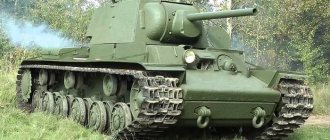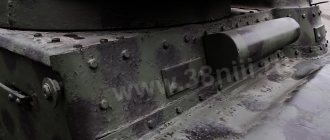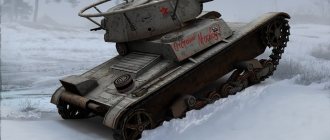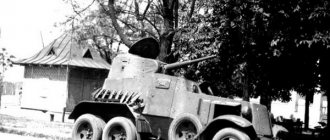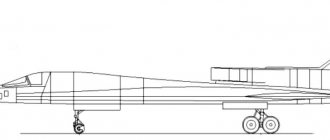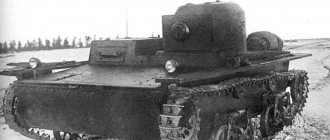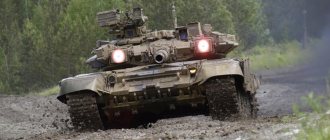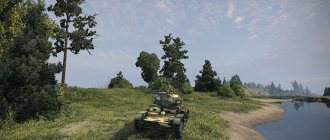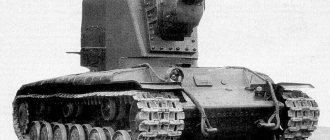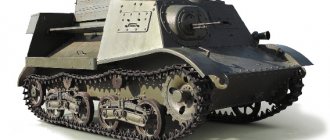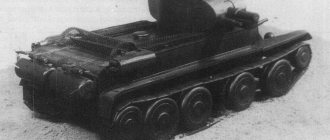The KV-1 heavy tank received its name in honor of Kliment Voroshilov. The history of this vehicle began at the end of 1938, when the USSR arose the need to create a new heavy tank. Similar attempts had also been made before this, but they all ended in failure. Options for tanks with multiple turrets were rejected because they were expensive to produce and unreliable.
Tanks that were too large were also not suitable, because it was impossible to install the required amount of armor on them. In the end, the developers settled on three options: KV-1, T-100 and SMK. Prototypes were created. The Soviet-Finnish company began, and all three tanks were sent to war.
The history of the creation of the heavy Soviet tank KV-1
In 1938, the USSR needed a tank that would have heavy shell-proof armor, capable of breaking through well-fortified enemy defense lines.
The first tanks vying for this role were the SMK and T-100 heavy tanks. These were tanks from a line of heavy multi-turreted vehicles that had similar features, namely a long tracked base, several turrets with guns of various calibers, enormous size and weight, and low maneuverability. After field tests, preference was given to the SMK tank.
The development of the KV-1 heavy tank began on February 1, 1939 at a plant in Kirov under the leadership of N.F. Shashmurina. The same SMK tank was taken as the basis. Although the KV was designed on the basis of the SMK, it had one huge difference - one tower. This made it possible to make the tank smaller, which had a positive effect on the chassis and armor characteristics, because it was possible to install more durable armor plates on the tank without compromising its maneuverability.
In April of the same year, the technical model of the tank was approved and sent for production of a prototype. In September 1939, KV and SMK tanks were rolled out to the test site in Kubinka. After testing, the KV tank was selected. Because of which? Firstly: because of one turret, with a good gun for that time, good armor, and, secondly, because of its mass of only 43 tons.
On December 19, 1939, the KV tank was adopted by the Soviet army. The tank was named after the People's Commissar of the USSR Klim Voroshilov.
Stories about weapons. KV - the first heavy Soviet tank (32 photos)
Author: zaCCCPanec
10 April 2022 15:32
Tags: stories about weapons history pages heavy tank KV
2714
32
Don’t rush to say that the KV was not the first heavy Soviet tank. It was not for nothing that we used the word “combat”. Yes, as a model built in series, the T-35 really became the first Soviet heavy tank. And it was quite suitable for parades. But its combat usefulness turned out to be more than conditional. However, we already wrote about this here: “Stories about weapons. Tank T-35. The most useless in the world?
0
See all photos in the gallery
So, without exaggerating too much, we believe that the KV heavy tank became the first real combat vehicle of the Red Army in this class. Having encountered a Soviet KV heavy tank in the very first days of the war, the Germans immediately dubbed it the “Ghost”. A machine that could single-handedly fight several opponents at once. A vehicle whose armor was not taken by anti-tank guns. A worthy opponent for any German armored vehicle. And in general, for any armored vehicles of that time.
0
Today there is a lot of material about this family of tanks. For every taste. From devastating criticism to deification. Accordingly, fans of wartime armored vehicles have already formed a completely opposite opinion about this magnificent or disgusting tank. However, everyone agrees that during the first period of the war it was indeed the most powerful tank. And it was he who largely endured the hardships of the most difficult time period of the Great Patriotic War.
×
0
There are plenty of examples of successful and demonstrative actions by HF crews. From the actions of Kolobanov’s crew near Leningrad to Konovalov’s crew near Voronezh. And the Germans themselves paid tribute to the combat vehicle, because if they could oppose anything, it was very, very little.
0
But the overall picture is impressive. And now it’s worth looking at where the KV came from. We are accustomed to viewing combat vehicles from ours today, with modern eyes and brains. Meanwhile, before the start of World War II, no one had any idea what characteristics a heavy tank should have. One could only guess about the effectiveness of this or that design. The T-35 breakthrough tank we have already mentioned.
0
Despite the fact that this five-tower giant was put into production, its participation in hostilities was very conditional, as we talked about at one time. A ceremonial tank that quickly disappeared in the first period of the war because it was not brought to perfection, that is, it absolutely did not meet the very requirements of that war.
0
Only in the second half of the 30s did the USSR finally develop at least some understanding of the very concept of a breakthrough tank. It was then that the famous “S. M. Kirov." The same experienced QMS with two towers, which became the basis for the development of Klim Voroshilov. Heavy tanks must not only have powerful weapons with 76 mm and 45 mm caliber guns, but also at least 75 mm armor on the sides, which would provide protection not only from a 47 mm gun at all distances, but also from fire from a 76 mm gun at range 800-1000 meters.
0
The KV tank itself appeared precisely as a smaller copy of the SMK. The designers, by removing the second turret, reduced the length of the vehicle. And quite strongly. For two skating rinks. It is interesting that in general the concept of this tank itself was not considered promising by management.
0
But there was one person who believed in the concept of a single-turret breakthrough tank. This is the head of the ABTU of the Red Army, corps commander Pavlov. It was at his insistence that graduates of the VAMM named after him were sent to develop such a machine. Stalin, who arrived at the Kirov plant to complete their graduation project. By the way, this explains the appearance of A. S. Ermolaev among the project leaders. Afanasy Semenovich Ermolaev was precisely the head of the diploma project of this group of graduates. Although, in our opinion, another leader, Leonid Egorovich Sychev, is undeservedly not mentioned. Sychev and Ermolaev managed the tank project together.
0
It turned out to be a tank. Leading designer Ermolaev presented the car in August 1939 under the symbol O-U. The O-U prototype actually had two guns: 76 mm (L-11) and 45 mm. In addition, three machine guns were installed on the tank - one DK and two DT. In addition to weapons, the vehicle received a diesel engine, torsion bar suspension and armor that was really not penetrated by armor-piercing shells of that time.
0
The chief designer of the new tank, which by that time had received the name Klim Voroshilov, was Nikolai Leonidovich Dukhov. During factory tests, the car performed quite well, although numerous deficiencies were discovered. There is a letter from the military representative of the Kirov plant, military engineer 3rd rank Kalivoda, addressed to the People's Commissar of State Control L. Mehlis, which directly states the need for urgent modification of this machine in order to accept it at least as a training vehicle. In August 1939, the first copy of the KV was manufactured. It is the KV, and not the KV-1, as is erroneously stated in some publications. The one, as paradoxical as it may sound, appeared later than the two. On November 29, 1939, one day before the start of the Soviet-Finnish War, three promising vehicles were transferred to the 20th Tank Brigade (T-28 tanks) for military testing - SMK, T-100 and KV. The KV conducted its first battle on December 17, 1939 during the breakthrough of the Khottinensky fortified area of the Mannerheim Line. The car performed quite well. As, indeed, do others. True, the SMK was blown up by a landmine on the third day of testing and was no longer used.
0
However, the military did not like the low-power gun. The L-11 simply could not cope with the Finnish fortifications. That’s when the idea came up to install a 152-mm howitzer on the KV chassis. The new tank was designated KV-2. And the first version of the car began to be called KV-1.
0
0
By the way, the KV was put into service a day after the first battle. December 19, 1939.
0
0
This was one of the reasons for abandoning the SMK and T-100. These vehicles, with the same weapon power (more powerful than the KV), were less armored, more difficult to manufacture and heavier than the KV. Although this decision caused a lot of controversy.
0
0
Today we can talk a lot about the losses in the first months of the war. Not so much about the losses, but about the fact that many vehicles were simply abandoned by the crews due to malfunctions and lack of fuel. But let's look at those who fought in 1941 on the KV. The vast majority of heavy tank crews had virtually no training before the first battle. Drivers, according to official data, had 3-5 hours of driving! Even such a small thing as instructions on how to operate a HF was in short supply. One per battalion! But even under such conditions, the KV made an impression on the enemy. The breakthrough tank was used as a defensive tank. Only an 88 mm anti-aircraft gun, 150 mm field guns and a 105 mm howitzer could take it. The rest of the artillery was only suitable for striking sparks and affecting the auditory receptors of tankers.
0
The Germans are also diligent students. Six months after the start of the war, German tanks received 50 mm and 75 mm guns, and at the end of 1942 the Tiger (Pz-VI) appeared at the front. "Tigers" hit KVs at a range of 1.5-2 km, while the 76-mm KV cannon could knock out a German vehicle from only 500 meters. At the same time, the Germans also introduced “Panzerjägerkanone” instead of “Panzerabwehrkanone”. Tank hunter gun instead of the Pak-40 anti-tank gun. The 75-mm cannon mounted on the chassis almost completely eliminated the superiority of the KV and T-34 in armor. Any hit from this weapon was considered fatal. While 50-mm sub-caliber shells had only 50% of fatal hits. So, in principle, a good KV tank became unnecessary for the army. But the Red Army did not think of abandoning heavy tanks. The traditional confrontation between armor and projectile began. Designers began to weight the vehicles with more powerful armor. The heavy tanks of the 1940-41 period were really heavy. Suffice it to say that the lightest such prototype weighed 60 tons!
0
And the armament of such vehicles inspired respect. At least 100 mm! An example of such a monster is the KV-7 prototype. It is better known to specialists under a different name - KV-220. A classic assault tank in the understanding of that time. Armed with three (!) guns. The main gun is 76 mm and two 45 mm guns. Such “artillery” played a cruel joke on the tank. He did not shoot where the gunner was pointing, but where the tank itself wanted. Even Voroshilov, after testing this prototype, expressed himself very figuratively: “Until today, I considered artillery an exact science.” Another interesting prototype is a tank with a pair of 76 mm guns. Can you imagine this car? There were prototypes with a howitzer gun (KV-9). There was even a prototype with missile weapons - the KV-1 KRAST. The designation “short tank missile and artillery system” was exactly what this tank had.
0
0
All of what was mentioned above is a rather complex decision. And in war conditions, solutions must be easy, cheap and technologically advanced. The simplest of these solutions seemed to be simply increasing the reservation on existing vehicles. Moreover, this applied not only to the KV, but also to the T-34 and T-28. These prototypes had the index "E". Additional masks were called screens. Hence E is shielded. A simple solution is not always a good one. The vehicles were designed for a certain weight and, accordingly, weighting led to a significant deterioration in the dynamic qualities of the tanks. In the case of KV, it generally looked stupid. The fact is that already in 1941 it was understood that the vehicle was over-armored. The desire to make a fortress on tracks led to completely unnecessary millimeters of armor on the sides and stern. Most of the hits were in the forehead. The solution was suggested by the military themselves. Units and formations often received complaints about the low maneuverability and speed of our heavy tanks. The commanders attributed heavy losses to this feature of the “fortresses.” The designers were tasked with increasing the speed of the tank.
0
A solution to the problem was found in the design bureau of the Chelyabinsk Tractor Plant. After analyzing tank losses in battles, ChTZ came to the same conclusion that we voiced above. And already in May 1942 they proposed a new tank - the KV-1S.
0
We don’t know where the decoding “C” came from as a special or high-speed one. Officially, this vehicle was called the KV-1 fast-moving tank. The speed has indeed been significantly increased. Up to 43 km/h. Due to what? By booking. By July 1942, this particular modernized version of the first series of the tank appeared. The armor on the sides was reduced to 60 mm. Armor casting began to be used, which also reduced weight. The design of the tower was changed to reduce its thickness. At the same time, a commander's turret appeared on it.
0
The KV-1S was equipped with a new gearbox, final drives, a new main clutch, and a new cooling system. Other materials were also used for the chassis. The vehicle received lightweight rollers, lightweight tracks, and a lightweight sloth.
0
There was an incident with this car. The KV-1S tank was put into service more than a week before the end of state tests, on August 20, 1942. And the car was tested until August 26, 1042. Thus, the vehicle went into production even before it was put into service.
0
It seems that all the requirements were taken into account, but... But it turned out that the KV-1S “didn’t make it.” Everything was fine, but in 1943 they sent Tigers and Panthers to the tank forces of the Wehrmacht, whose guns coped quite well with KV armor, but our tank could reciprocate with great difficulty. The 76 mm gun clearly required replacement. In addition, the strengthening of the armor of the classic Pz-IV as a whole completely negated all work on the HF. First of all, a more powerful weapon was required. For example, the 85 mm D-5 gun.
0
The gun and even the turret were already ready. True, they were intended for the new tank - “Joseph Stalin”. Taking someone else's tower was quite difficult. The fact is that the turret for the IS was made in Chelyabinsk, and the KV chassis was produced in Leningrad. Therefore, the Kirov plant created its own model of the tower. Ultimately, the KV-85 still received a turret from the IS, but one single copy of the “original” KV-85 has survived to this day and stands as a monument on Stachek Avenue in St. Petersburg. This is exactly the same prototype with its own (Leningrad) turret. But, alas, time has not been kind to the KV-85 with an IS turret, and they can only be seen in wartime photographs.
0
The machine that you can see, touch and inspect, the one you see in our photos, is another modification of the KV. More precisely, KV-8. Our Soviet flamethrower tank, which sowed panic among German soldiers and officers. “Everything was burning!” - it's about him. Only 139 units of these vehicles, together with the KV-8S, were produced. Few? It's hard to say; it depends on the specifics of the application.
0
At first glance, the car is almost no different from a regular one. Cannon, coaxial machine gun, regular chassis. In fact, the principle “don’t believe your eyes” applies here.
0
A gun of a decent caliber, seemingly normal for a heavy tank, is nothing more than an imitation. In fact, this is a 45 mm gun in a camouflage casing. And there is no machine gun in its usual place! There is an ATO-41 “Serpent Gorynych” flamethrower there. ATO - automatic tank flamethrower. Effective at a range of up to 130 meters - there was nothing alive left! The Germans, seeing the KV-8 or T-34 from the ATO, simply fled from their positions. Another question is that identifying the flamethrower tank was not easy. Actually, “Snake Gorynych” is the name given to the T-34 tank with ATO. Later the name spread to the KV, and to the flamethrower itself. And this miracle of technology was produced (at that time no one else in the world produced such weapons) in the village of Karabalykh, Kustanai region. In an ordinary grain farm. These are the kinds of miracles that happen.
0
And we will finish our story about why the KV tank is eternal. That's right - eternal! Eternity is the short duration of life of a single specimen or individual. Eternity is a continuation in descendants! The descendant of the one who died in the first months of the war, the one who burned defending the retreating troops, became the most formidable, strongest tank of the Second World War! Yes, the family of heavy ISs are direct descendants of the clumsy, poorly armed KVs, with many defects and design errors. KV simply changed his last name. The KV-13, also known as object 233, a heavy armored medium tank created at ChTZ in 1942, became the IS-1 tank. But the KV-9 with the 122-mm U-11 tank howitzer, object 234, became the IS-2. The creation of new equipment, especially military equipment, is always associated with many problems that are identified already in the process of pilot production. But most of the problems are revealed in battle. This is especially true for completely new developments.
0
“Klim Voroshilov” was the first Soviet heavy tank; the T-35 is generally difficult to consider as a combat vehicle. So the KV and its further development can be considered a machine that influenced not only domestic tank building, but also Western schools of designers. So in any modern tank there is a small part of it.
Source:
Tags: stories about weapons history pages heavy tank KV
Did you like the post? Support Chips, click:
91 2 89
Liked
89 2
8
Partner news
Armament of the KV-1 heavy tank
At the beginning, the KV-1 tank was equipped with two twin cannons of 76.2 mm and 45 mm calibers. Later, after testing, instead of the 45-mm 20K cannon, a DT***-29 machine gun was installed. During the war with Finland, the 76.2 mm L-11 cannon was replaced with a 76 mm F-34 cannon. In the fall of 1941, the KV-1 was re-equipped with a ZiS-5 cannon, because it was more reliable than the F-34. The ZiS-5 gun had a longer barrel length - this was also one of the reasons for abandoning the F-34.
Characteristics of the weapon
- Weight of gun, kg – 455
- Initial flight speed of an armor-piercing projectile, m/s, - 662
- Initial flight speed of a sabot projectile, m/s, - 950
- Initial flight speed Oskol.-High-explosive. projectile, m/s, - 680
- Maximum flight range Oskol.-High-explosive. projectile, m – 1329
- Sighting range, m, — 1500
- Vertical aiming angles, degrees: -5°…+25°
Armor penetration:
- Armor-piercing, At a distance of 500 m, mm/deg. — 84/90°
- Armor-piercing, At a distance of 1.5 km, mm/deg. — 69/90°
- Rate of fire, rds/min – From 4 to 8
Additional weapons:
Three DT machine guns, 7.62 mm caliber. One is a coaxial machine gun, another is a course machine gun mounted in the front of the hull, and the third is installed in the rear of the turret.
First fight
When the Soviet-Finnish War began, the Soviet army had the opportunity to test its heavy tanks in real combat conditions. So the KV was sent to the front - this took place on December 18th. The heavy tank proved itself successful, and literally the next day an order was received to put the KV into service. Many historians agree that this decision was a grave mistake.
Indeed, the Defense Committee approved the serial production of a combat vehicle, which did not even fully pass the entire factory test cycle. The basis for making a decision was based on just one success on the battlefield - the decision was more emotional, not thought out. The designers were also given instructions to assemble another KV, but with a 152 mm tank gun.
Finished copies appeared already by the time the outcome of the Soviet-Finnish war was actually a foregone conclusion. But their usefulness is undeniable - they were used to break through defense lines. So in 1941, a combat vehicle with a 152 mm howitzer was called KV-2, when a vehicle with a 76 mm cannon was called KV-1.
Tactical and Technical Characteristics of the KV-1 tank
- Weight, t – 47
- Crew, h. – 5. Commander, Driver, Gunner, Loader, Gunner-radio operator.
- Case length, mm — 6675
- Case width, mm — 3320
- Height, mm – 2710
Reservations:
- Body forehead (top), mm/deg. — 75 / 30°
- Body forehead (middle), mm/deg. — 40 / 65°
- Body forehead (bottom), mm/deg. — 75 / 30°
- Hull side, mm/deg. — 75 / 0°
- Hull stern (top), mm/deg. — 60 / 50°
- Hull rear (bottom), mm/deg. — 70 / 0—90°
- Bottom, mm - 30-40
- Housing roof, mm - 30-40
- Turret front, mm/deg. — 75 / 20°
- Gun mask, mm/deg. — 90
- Tower side, mm/deg. — 75 / 15°
- Tower feed, mm/deg. — 75 / 15°
- Tower roof, mm - 40
Ride quality:
- Engine V-2K power, hp — 500
- Maximum speed on the highway, km/h - 34
- Cruising range on the highway, km - 150-225
- Specific power, l. s./t - 11.6
- Climbability, degrees. – Unknown.
Historical reference
It is known that the very first tank MK-I (Mark I) appeared on September 15, 1916 in the British Army. France did not lag behind its Entente ally, presenting its combat vehicle a little later. The Renault FT tank turned out to be quite a successful option and a model for many subsequent models.
Following the pioneers, Italy, Hungary, Poland, Sweden, Czechoslovakia, and Japan joined the tank building process.
It is curious, but the countries that are today producers of the best armored vehicles - Russia (USSR), the USA and Germany - entered this process with a certain delay.
The Soviet military command had virtually no experience in the construction and use of tanks.
It was difficult to call the use of combat vehicles captured from the interventionists and one and a half dozen tanks manufactured in 1920, on the basis of a slightly converted Renault (the first was called “Freedom Fighter Comrade Lenin”), an experience.
Therefore, having gone through the stage of finding their way faster than other tank-building countries, the creators of Soviet tanks found a more successful option.
Combat use of the Klim Voroshilov (KV-1) heavy tank
The first combat use dates back to December 17, 1939 during the breakthrough of the Mannerheim Line. However, only a prototype of the tank participated. Serial production was launched only in 1940.
Great Patriotic War (1941-1944) – Actively took part in the Second World War. During 1940-1942, 2769 tanks were produced. True, he did not fight until the end of the war. Until 1943 (the appearance of the Tiger tank), the KV-1 was the most powerful tank of the Second World War, which played a significant role in containing the onslaught of German troops.
More material on the topic
- M4 Sherman
- New deadly tank T90MS
What was the power of the KV-1
The history of the KV tank turned out to be difficult and short-lived. The car was built in about 1 year, and serial production lasted only 3.5 years. After the appearance of the Tigers and Panthers, the need for more advanced heavy tanks arose. However, the fate of the KV-1 could have been completely different if not for a number of not so much technical as organizational errors.
However, the KV-1 had several defining advantages that made it stand out on the battlefield. For example, thanks to thick armor, the vehicle could maneuver freely , avoiding the damaging fire of enemy anti-tank guns; the rear machine gun actually eliminated the need for infantry escort. During the Great Patriotic War, the KV-1 was considered one of the most protected tanks on the battlefield. Most enemy anti-tank guns could not “take” it. This gave the Klim Voroshilov superiority against armored vehicles and artillery batteries.
The design of the KV-1 was considered advanced at the beginning of the 40s of the last century. The design could only be compared with the legendary T-34. The designers managed to combine all the advanced solutions at that time into one tank: inclined armor, a diesel engine, and a long-barreled gun . Subsequently, various modifications were created on the basis of the KV-1, which received modern solutions at that time and improved characteristics, which was a necessary measure. For decades after the end of the war, no one remembered the KV-1. Perhaps the main reason for this is that mainly T-34s were used in cinema, since technically serviceable KV-1s were very rare after 1945. Nevertheless, the KV-1 left a serious historical mark, creating a terrifying impression on the enemy.
The first prototype of the KV tank (U-0 vehicle) before being sent to Moscow, September 1939.
The first prototype of the KV tank (U-0 vehicle) before being sent to Moscow, September 1939.
KV-1 with a cast turret and hull manufactured at plant No. 200, spring 1942.
KV tanks go on a combat operation, Leningrad Front, December 1941. The rear vehicle has additional armor on the sides and turret.
Tank KV-1, Kalinin Front, January 1942.
KV-1 moves to the attack line, 43rd Army, 109th TD, Leningrad Front, end of August 1941.
KV-1 with a cast turret manufactured by UZTM on the streets of Moscow, January 1942.
KV-1, winter 1942.
Troops dismount from a KV-1, North Caucasus, Prokhladny area, 1942.
edit this post
The first tank of the Soviet Union
It must be said that military engineers of the Soviet Union at the beginning of 1920 decided to invent the first Soviet tank. It was built almost the same as the French car Renault ft-17. At one of the plants in Nizhny Novgorod, designers dismantled a French tank literally down to the screw and thus were able to see the full picture of the drawings and design of this vehicle.
French tank Renault ft-17
It took almost 2 years to build the first Soviet tank, which by the way was called “Freedom Fighter Comrade Lenin”. Only in 1921 was this vehicle put into service with the army.
It should be noted that the first Soviet tanks were clumsy compared to those that took part in World War II. The first examples of such combat vehicles reached a speed of only approximately 9 km/h. Their cruising range was only 60 km.
Expert opinion
Konstantin Pavlovich Vetrov
Assistant and Advisor to the Minister of State Control of the USSR, Hero of Socialist Labor, historian, Doctor of Historical Sciences. Author of many scientific works on the history of the Soviet Union.
The armor was not thick and was approximately 6 mm. There were two people in the crew. After the first such vehicles were delivered to army soldiers, only 14 similar types of military equipment were produced throughout the year.
If we talk about the French model of the tank, which was converted in the Soviet style, then it was never allowed onto the production line.
In military and peaceful spheres
The decision to return to Leningrad was ambivalent. On the one hand, Shashmurin found himself outside the influence of Kotin, with whom he remained in a tense relationship. On the other hand, Nikolai Fedorovich, one might say, temporarily fell out of the process of creating a new generation of heavy tanks. He managed to participate in the development of the IS-6 project, but in the next round of the struggle between plant No. 100 and ChKZ, Dukhov and Balzhi won, who created Kirovets-1 - the very IS-2 modernization project that was demanded at GBTU KA.
Shashmurin spoke poorly of this tank, which was put into service as the IS-3. He believed that the car was a half-measure and a new “tank of extreme parameters” was required. Another question is that the creation of a completely new tank took time, and the unsuccessful experience of creating the Object 701, adopted on April 26, 1946 as the IS-4, showed that the IS-3 is the best solution - yes, it is not so well protected, but it is lighter and uses a number of IS-2 units. The rush to launch the tank into production later resulted in a lot of problems that had to be solved after the end of production. Nevertheless, the IS-3 was still a successful tank.
KT-12 is the first vehicle developed with the participation of Shashmurin at the Kirov plant after returning to Leningrad.
© warspot.ru
Meanwhile, the Kirov Plant mastered the production of the IS-2, however, during the entire period it was possible to deliver only ten tanks of this type. But it worked with the ISU-152 - they were produced in Leningrad until 1947. At the same time, work was going on in a different, peaceful direction. We are talking about the KT-12 skidding tractor, which was developed on the basis of the German-Austrian artillery tractor Steyr RSO/01. The task for its creation was given back in the spring of 1944. Taking the German design as a basis, the Kirov plant created its own design. As deputy chief designer, Shashmurin initially played one of the key roles in the creation of the KT-12. This continued until 1946, until Malyshev, already the Minister of Transport Engineering (NKTV was reorganized into the Ministry of Transport in 1946), gave instructions to switch to another, purely military work.
Beam torsion bar suspension. Along with the ejection cooling system, such designs developed by Shashmurin for the Object 260 were later used in a number of other Leningrad tanks.
© warspot.ru
At the beginning of 1945, the development of a new generation heavy tank began at Plant No. 100. It received the designation IS-7, and was also called Object 257. The vehicle was created jointly with NII-48, and therefore had a very unusual hull and turret design. The V-shaped design of the bottom forced at first to abandon the torsion bar suspension, replacing it with a blocked one, but later torsion bars returned to the IS-7. Since the end of 1945, work began on the main version of the machine - Object 260.
For him, Shashmurin came up with a beam torsion bar suspension: instead of one long torsion bar, several short ones were installed, which made the design more compact. In addition, beam torsion bars turned out to be more effective. Shashmurin also developed an ejection cooling system, which turned out to be more efficient, and a different gearbox design was being worked on. Finally, his field of activity became the general technical management of the project, as well as the general layout of the tank. When creating the latest, most advanced version of the tank, Shashmurin became the lead engineer of the vehicle. It is interesting that Kotin appointed him to this position.
Water jet propulsion system created by Shashmurin for the PT-76. He later served as the machine's lead engineer.
© warspot.ru
The IS-7 had an unfortunate fate - the car turned out to be too heavy, complex and expensive. There was already negative experience with the IS-4, which was a little lighter (60 tons), but no less problematic. Therefore, in February 1949, a command was received to stop work on the IS-7, and they decided to use the developments on it in a new tank - Object 730. Shashmurin was removed from work on this vehicle, which was jointly created by the Chelyabinsk and Leningrad design bureaus. At the same time, he himself considered this tank, adopted for service as the T-10, to be unsuccessful. According to Shashmurin, it was necessary to create a tank with a combat weight of 58 tons, which would make maximum use of the developments on Object 260.
The Ministry of Transport and Machinery thought completely differently, and it’s hard to say that they were wrong. The T-10 turned out to be a successful tank, in which, by the way, the developments from the Object 260 were very much used - these were beam torsion bars, and an ejection cooling system, and in terms of its hull it was closer to the IS-7. As for Shashmurin, his experience was used to create a completely different tank. We are talking about the amphibious tank Object 270, soon renamed Object 740. On its basis, the armored personnel carrier Object 271, renamed Object 750, was simultaneously developed. These combat vehicles are known as PT-76 and BTR-50. Both vehicles used not only an ejection cooling system, but also water jets, which were designed by Shashmurin. Subsequently, Nikolai Fedorovich was the leading engineer of these machines, bringing them into serial production. On the basis of the BTR-50, he developed several vehicles, one of which was the Antarctic all-terrain vehicle "Penguin".
In the 50s and 60s, Shashmurin worked on a whole series of experimental tanks, including those equipped with missile weapons.
© warspot.ru
The 50s and 60s became a time of new work for Shashmurin. Despite the fact that he was not directly related to the T-10, heavy tanks continued to be one of his priorities. In 1955-1957, he oversaw work on the creation of a new generation of heavy tanks - Object 277, as well as Object 278. He was directly related to a completely new type of combat vehicle - Object 282, a rocket-powered heavy tank destroyer. And Nikolai Fedorovich had a very direct connection to the subsequent Leningrad missile tanks. He also worked on installing gas turbine engines in tanks and other vehicles. However, all these machines were experimental. The real success was not the tank or the launcher, but the wheeled tractor. Since 1959, Shashmurin was one of the leading developers of the Kirovets K-700 wheeled tractor, which was produced in different versions for forty years.
Layout
It became a classic for Soviet heavy tanks during WWII: in front there was an OU in which the driver and gunner-radio operator sat; behind it was the battlefield, where the gun crew, led by the commander, worked; in the stern there was a MTO with a 500-horsepower V-2 diesel engine and fuel tanks. I note that after the loss of KhTZ, a number of “boxes” were equipped with a gasoline M-17T of the same power.
The hull was welded from armor plates of various thicknesses; the bow and stern had a rational slope; the towers were of three types: solid cast and welded with a rectangular and rounded rear niche; they were mounted on a shoulder strap with a diameter of 1800 mm.
The disembarkation and embarkation of the crew was carried out through the turret and hatch in the front part of the hull; in addition, a manhole was provided in the bottom. The HC was represented by six paired support and three support rollers, usually not rubberized, the rear wheels were driving, and sloths were located in front.
One of the distinguishing features of the KV was the huge tracks, 700 mm wide, which ensured relatively low pressure on the ground of the almost 50-ton colossus.
KV-1 in battle
KV-1 had the following performance characteristics:
- Dimensions - 6.68/3.32/2.71 m.
- Weight - 47.5 tons.
- Reservation - inclined: 60-75 mm; vertical: 75 mm; horizontal: 30-40 mm.
- Engine - 1×500 l. With.
- Speed - 34 km/h.
- Cruising range - 225 km.
- Armament - 1x76 or 85 mm; 3×DT – 7.62 mm.
- Crew - 5 people.
A total of 3,225 units were produced until 1942.
Modernization and mechanization of military equipment in the USSR
In 1929, the Party's Central Committee adopted a special resolution, according to which the Soviet army should be modernized and rearmed in the near future. Officials demanded from the designers, as well as the leaders of the Red Army, that new models of tanks, artillery installations, and aircraft enter service in the near future.
Light tank T-26
In addition, specific goals were set for army leaders for the next few years. The Red Army must be larger in number than any army in the world. Also in service must be new types of aircraft, artillery and tanks, which must be developed and delivered to the army. Officials planned that military designers would be able to produce more than 1,000 new tank models within five years.
Which tank is better?
T-34T-100
It must be said that at that time the Soviet Union lagged significantly behind countries such as Great Britain, France and Germany in its tank development development. For example, at that time the Soviet tank regiment consisted entirely of captured vehicles that were captured in various battles.
Expert opinion
Isaac Yakovich Zelder
Soviet astrophysicist, physical chemist, Doctor of Physical and Mathematical Sciences, Academician of the USSR Academy of Sciences, designer, engineer. Hero of Socialist Labor of the USSR.
A special organization was established to develop and build tanks. At that time, the main design bureau had already provided one of the first Soviet T-17 tanks.
A project for the T-16 tank was also presented, which was very light and had to move and defend on the battlefield with infantry cover. A heavier and more advanced T-12 tank was also presented. It was he who became the first tank that the Kharkov plant produced; in the future it would produce most of the Soviet tanks, including the legendary T-34.
Tank T-12
In the 1930s, the T-16 was modernized and it was the main combat vehicle of the Red Army. For its time, it was quite maneuverable, and also had good weapons and armor. With the support of infantry, this tank at the front had the ability to quickly maneuver and also carry out lightning attacks on less mobile enemy tanks and vehicles. But, despite its positive qualities, this car was far from ideal and had several big disadvantages.
For example, the tank turret and the machine gun were directed towards each other, in such a way that it was not possible to fire from two guns at the same time. Therefore, already in 1930, this tank was modernized again, at that time it was equipped with a completely new turret, which was developed already in the USSR, and not according to the French model. In 1931, this tank was removed from service by the Soviet army. In total, it was produced in the amount of 900 cars.
Speed and maneuver
All tanks of the KV family, including the KV-1, were equipped with a four-stroke V-shaped 12-cylinder diesel engine with a power of 500 hp. After strengthening the armor protection and increasing the combat weight of the KV-2 tank, the power was increased to 600 hp. This engine allowed the combat vehicle to reach speeds of up to 34 km/h.
A big problem for tankers was the transmission, which consisted of a five-speed gearbox (including reverse speed), planetary onboard mechanisms, multi-disc (main and two side) clutches and band brakes. All drives were mechanical and difficult to operate. Experts clearly assess the transmission of KV tanks as the weakest side of the combat vehicle.
The chassis is the most vulnerable point, like all tanks.
The KV-1's suspension is individual, torsion bar with an internal shock absorber for each of the six double small-diameter rollers on each side. The drive wheels with removable pinion gears were located at the rear, and the idlers were located at the front. The caterpillar tension mechanism is screw. The number of 700 mm wide tracks in the caterpillar varied from 86 to 90 pieces.
Using the experience of others
During the Soviet period, they tried not to mention this, because the country of the Soviets was the first in everything. This “leavened patriotism” is to the detriment of historical truth. Yes, we didn’t invent the tank... Yes, our designers used the experience of others. And what's wrong with that?
In December 1929, a special commission created by the Department of Mechanization and Motorization of the Red Army was sent on a business trip abroad to study the production of tanks.
Were purchased:
- A sample of the light English tank "Vickers - 6 tons" with a production license.
- 15 MkII tanks, English-made.
- Several Carden-Lloyd MkVI wedges and a license for the production of this model.
- Two TZ tanks without turrets and weapons in the USA from engineer and inventor J.W. Christie is the author of the original chassis for the armored vehicle.
All these acquisitions were used in one way or another in the development of domestic tank models. On the basis of the English wedge, the T-27 wedge was created and put into mass production, which was in service with the Red Army even in the first months of the war.
When creating the T-26 tank, which in the pre-war years was the main one for the Red Army, the achievements, important components and assemblies of the Vickers - 6 tons combat vehicle were largely used. And the original chassis, invented by Christie, was first used on tanks of the BT family, and then on thirty-fours.
